This from Martin Nowak:
Former Chicago Fire Department Rigs
Former 6-3-3 1954 FWD, former engine company, converted into a foam unit at Meigs Field.
Former Academy engine – 1988 Ford/E-One, never assigned to a regular engine company.
Former Engine 30 – 1969 International/Pierce.
Former Tower Ladder 5 – 1988 Federal/E-One 95′
X- Tower 34 – 2002 Pierce 100′, involved in an accident years ago. Former Engine 115 – 1980 Ford/E-One.
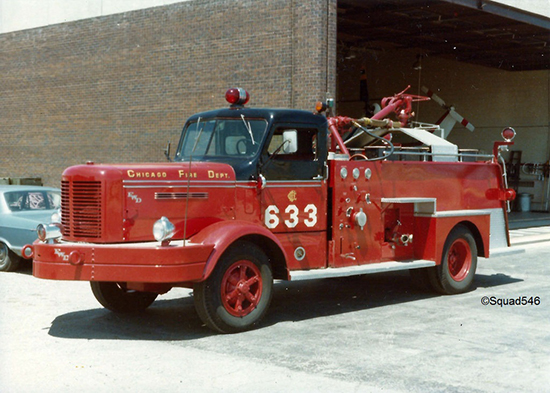
Squad546 photo

Squad546 photo
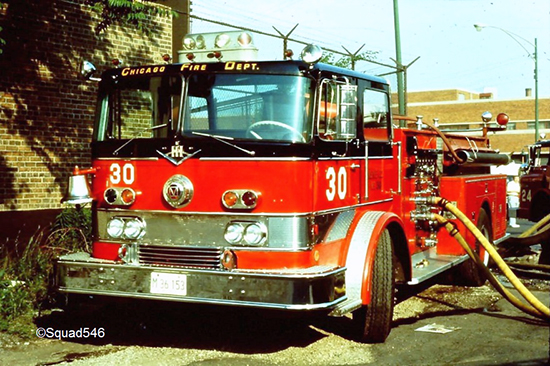
Squad546 photo
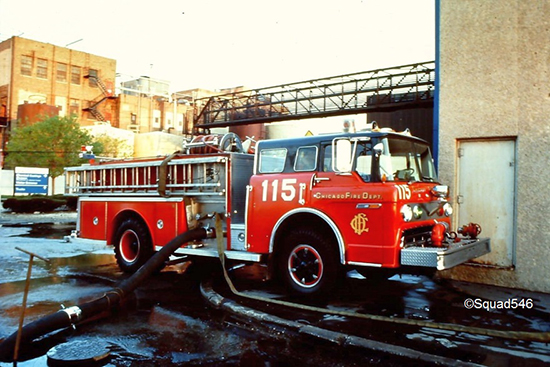
Squad546 photo
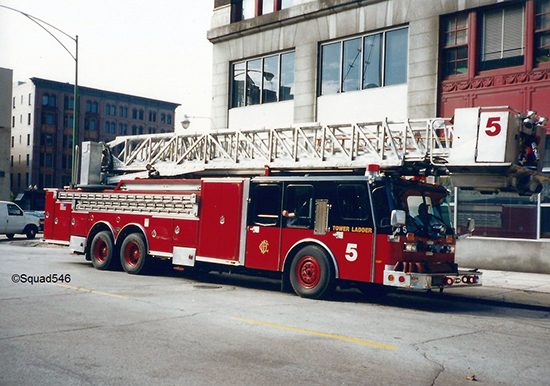
Squad546 photo
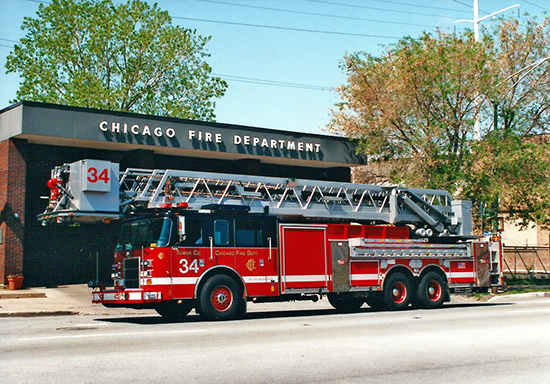
Squad546 photo



















































#1 by Phil Stenholm on September 13, 2014 - 11:49 AM
Also, the CFD added a second Oshkosh-Pierce 1250 GPM pumper in 1972 (at 84), and then the three new 75-ft 1250/500 snorkel-quints placed into service with S3, S4, and S5 in 1974 were also Oshkosh-Pierce rigs. So the Oshkosh-Pierce snorkels looked a lot like the two Oshkosh-Pierce pumpers, except with a snorkel boom added. And then that was it as far as Oshkosh-Pierce deliveries to the CFD is concerned.
There was also a custom-built Oshkosh/FMC/Bean airport pumper placed into service with Engine 9 at O’Hare in 1976. It was later converted to a snorkel-quint, and ran as Squad 7 at O’Hare for a number of years. (Before it was assigned a Spartan Super-Vac heavy rescue in 1988, Squad 7 operated with a snorkel and a GMC/E-One mini-pumper).
#2 by Phil Stenholm on September 13, 2014 - 11:10 AM
TOM S: Not Bill here, but Engine 98 had a “one-off” custom-built 1970 Oshkosh-Pierce 1250 GPM rig for a couple of years, then it was moved to Engine 91 for another nine or ten years after that, and then Engine 18 after that.
The Oshkosh-Pierce was unique in that it was the first Pierce pumper built on an Oshkosh chassis, and it did indeed have a boat-load of chrome trim. No wonder it was put into service at Engine 98!
BTW, at the time the seven Ward LaFrance HVPs were delivered in 1970 (see Bill’s Post below), the CFD had only five 1250 GPM pumpers in service (a 1967 Ward LaFrance at 34, 54, and 107, a 1969 Seagrave at 42, and the Oshkosh-Pierce at 98) and no 1500 GPM pumpers. So while it might not seem like that big of a deal now, a rig that could pump 2000 GPM was quite an advance for that time.
#3 by tom sullivan on September 13, 2014 - 5:27 AM
bill,
you would know,,,i recall that e-98 had an international / fwd / Oshkosh ( or some thing like that) branded rig before the ALF 2000 gpm one. I think there might have been another one also out there. it was real show rig, lots of chrome, stainless steel trim. the rig was long, a very large cab with plenty of room in front. it was maybe 1500 or 1250 gpm rated. it was at e-91 it the early 80’s in the old house on Elbridge.
#4 by Bill Post on September 13, 2014 - 2:55 AM
Fred Engine 98 was labeled as a High Volume pumper and it was one of 18 2000 gpm (gallons per minute) pumpers that Chicago at one time had. That doesn’t include Engines 9 and 10 at O’Hare Field which became 2000 gpm pumpers when they had received their 1988 tandem rear axle super pumpers which were equipped the Tele Squirts at the time.
I understand the current Engine 60 (and perhaps a few other) actually has a pump on it that is has a 2000 gpm pump on it even though most of the pumps on the Spartan Ervs, Crimson and Luvernes are officially rated at 1,500 gpm. Engine 60,5, 42 and the current Engine 98 are classified as triple stage “high pressure” pumpers , which when their pumps are engaged in the “third stage” are capable of sending streams of water to the upper floors of high rise buildings at very high pressures. The feature (to my understanding) would be used when a high rise buildings own pumps are not operational as special procedures must be carefully followed as well special re enforced hose must be used because of the high pressures involved when the pump is engaged in the third stage.
That’s another story however. Now getting back to Original 2000 gpm pumpers of the Chicago Fire Department. The Original 2000 gpm pumpers were 7 (1970) Ward La France 2000 gpm pumpers of which 6 of the 7 were rebuilt in the late 80’s using Ranger Cabs and E/One components in addition to having a 140 gallon foam tank added and an large deck gun added as well. Those Engines after being rebuilt didn’t last that long however a few of them achieved celebrity status as a couple of them were used for the movie “back draft”. If you were at the annual Fire Buffs of Illinois and 5-11 club annual swap meet this past June (2014) at the Fire Academy you would have seen one of the rebuilt Ward La France Engines on display made up to look like the “Engine 17” from the movie Backdraft. That rig belongs to a private owner.
When the 7 1970 Ward La France Engines were delivered (during the administration of Fire Commissioner Robert J Quinn), the idea was to have the 2000 gpm , pumpers spread around the city. As there were 7 fire divisions at the time the Quinn administration had assigned one 2000 gpm pumper to each Fire Division.
The Original 2000 gpm Ward La Frances were assigned as follows
1. Engine 8 located in the 1st Division
2. Engine 113 located in the 2nd Division
3. Engine 22 located in the 3rd Division
4. Engine 49 located in the 4th Division
5. Engine 126 located in the 5th Division
6. Engine 106 located in the 6th Division
7. Engine 73 located in the 7th Division.
Two Years later six (1972) American La France 2000 gpm pumpers were delivered. Five of the 6 ALF pumpers were assigned to the traditional downtown companies which were Engines 98,42,13,1 and 5. The sixth ALF 2000 gpm pumper was assigned to Engine 103 on the near west side.
About 6 years later in 1978 the Chicago Fire Department had purchased 5 more American La France 2000 GPM pumpers that were on different model chassis and cab then the 1972 models and without the “Aurora Borealis” light ( the red and white lights under the transparent dome) that the CFD had on the earlier rigs. The 5 1978 models were assigned to Engines 89,20,34,64 and 46. With the exception of Engine 20 most of the other 1978 were spread out to the far ends of the city and both Engines 89 and 64 were pretty slow companies in terms of fire runs.
I believe that the logic of giving them to Engines 89 and 64 was that if a 2000 gpm was needed to be special called on the far northside or on the far southwest side they would most likely be available as both of the those companies were amongst the slowest in the city.
Most of the Original companies that were assigned the 1970 Ward La Frances and 1974 American La Frances had their 2000 gpm Engines
replaced in 1981 and 1982 were replaced with Emergency One standard 1,200 gpm pumpers on the Ford C cab chassis in 1981 and 1982. Apparently the need for 18. 2000 gpm pumpers really wasn’t there and it had been a case of “overkill” as well as apparently maintenance and cost issues so with the exception of Engine 98’s rig (which was rehabbed and received the official “High Volume” designation every other of the original 13 ,2000 gpm companies were reverted back to being a standard lower pump capacity and lighter weight Engine companies. By the mid 1980’s the Chicago Fire Department had felt that maintaining about half a dozen 2000 gallon per minute pumpers spread out around the city would be adequate.
Beginning in 1988 the Chicago Fire Department had begun a program of totally rebuilding some pumpers with new bodies cabs and parts. The first apparatus that was rebuilt were the 10 1974 model Mack M/B cab Howe short wheel base pumpers. The second and the group of Engines to be rebuilt were 6 of the 7 1970 Ward La France 2000 gpm pumpers using as previously mentioned Ranger cabs and E/One bodies with the addition of a 140 gallon foam tank and high capacity deck gun and some heavy suctions.
The idea was also to spread the rebuilt Ward La France pumpers around the city and to place one in every district which was very similar to what was done when they Original 7 were put in service in 1970. It was also decided that all 6 rebuilt former Ward La France 2000 gpm pumper would be located off of the expressways so that they could get around the city fast if called for and also because of their added self contained foam capacity. As most readers of this site already probably know the companies that had the rebuild Ranger/ E-One rigs were assigned to Engines 122,14,69,113,46 and 34. Even though the original idea was to have one Engine per each of the 6 new Districts ( that had replaced the 7 Old Divisions in the early 1980’s) that really wasn’t the case as two of the rebuilt Engines were assigned to the 4th District and none of them were technically speaking assigned to the 2nd District. Both Engines 34 and 113 were located in the 4th District. While Engine 69 was officially assigned to the 3rd District ,in reality Engine 69 was really located near the border of the 2nd and 3rd Districts. Before the 6 rebuilt Engines were officially assigned I had read that they were originally planning to assign one of the Engines to Engine 35 ,which was located in the 2nd District however with Engine 14 and 69 both located off of the Kennedy expressway they decided not to give one to Engine 35. Most of the rebuilt 2000 gpm pumpers were out of service by the mid 1990’s. Beginning in 1992 with first group of Spartan Luverne pumpers all of our Engines since then were rated at 1,500 gallon per minute with the few exceptions of Engines 9,10 and 60.
The irony is that the New York City Fire Department which currently has a fleet of 205 pumpers ( if you include their 7 Squad/Pumpers) has started to order all of their new Engines with 2000 gpm pumps over the last few years. Before that only 6 of their pumpers were of 2000 gpm capacity since the early 80’s as part of their “Maxi Water ” response system which had replaced their famed Super Pumper. All of their other Engine companies were of 1,000 gpm capacity until the last few years.
#5 by Danny on September 13, 2014 - 2:21 AM
Rare shot of the academy Ford before the Amber lenses were put on the lights
#6 by Fred on September 12, 2014 - 8:15 PM
Bill…great info. Can you advise the difference between your illustration of high pressure wagons and what Engine 98 was classified as? Didn’t they call it a high pressure pumper or high volume something or another?
(also, the Hendrickson rig {SS-1} was a real work horse!)
#7 by Bill Post on September 12, 2014 - 7:52 PM
David that International Pierce Snorkel was assigned to Snorkel 4 all of it’s life. When they were put in service they were originally assigned to Engine 25’s quarters at the Fire Academy however when Truck 31 was relocated from Engine 104’s old quarter (1401 S Michigan) to their current quarters Snorkel 4 was moved in with Engine 104 on March 9 1970 and on June 1st 1972 they were relocated to Engine 67 at 4666 W Fulton ( 2 blocks from Lake street and Cicero ave). They received a new Oshkosh /Pierce Snorkel sometime in 1974.
Chicago’s Original Snorkel Squads 1 and 2 were built on 1956 International Harvester chassis that were originally built for Chicago’s High Pressure Wagons in 1956 and were taken out of service to have a new bodies and 2 40 Snorkels installed on them in 1961/62.
Chicago’s High Pressure Wagons were “Heavy Duty” Hose Wagons that had 2 beds of large diameter (at the time) “boat hose” and they were also equipped with one and (in some instances two) large fixed turret (deck guns) nozzles on top of the body. They carried no pumps however.
It is ironic that the second piece’s of the Original Snorkel Squads were also were also built on International Harvester chassis however they were 1960’s vintage Fog Pressure wagons that were in reality mini pumpers that were equipped with a 300 gallon booster tank and had 2 reels of high pressure booster hose and special (gun type) High Pressure Fog nozzles on them which were used for quick knock down of fires as in those days (the early to mid 1960’s) very few of Chicago’s Engine companies were equipped with booster tanks. Of 123 Engine companies (at the time) only 10 , 1956 model Mack pumpers had been delivered with booster tanks on them and a couple of other Engines had been retro fitted with a booster tank but there were less then 15 Engines so equipped until Chicago start getting Engines delivered in late 1966/early 1967 and from then on Chicago’s Engines were all delivered with booster tanks on them.
#8 by Jim Mitidiero on September 12, 2014 - 1:04 PM
The photo of Engine 115 was taken at 115th & Champlain. In the background is the Sherwin Williams Paint Co. which is pretty much gone now. There was a Fire Cistern near the southeast corner and the Chief would have companies come there on Sundays to drill on drafting operations. I saw this many times as I worked there for many years before going over to the dark side and joining the CPD. While working there we had our own in plant fire brigade which did a lot with companies in the old 17th Battalion.
#9 by David on September 12, 2014 - 11:24 AM
There was also at least one IHC Snorkel purchased in 1966 (can’t remember which company got it). Great looking rig, dayton wheels unlike the engines. I’d love to see a color photo of that rig, never seen any.
#10 by Bill Post on September 12, 2014 - 11:18 AM
There were a total of 2 International Harvester Engines. They were originally assigned to Engine’s 4 and 25. They eventually became hand me downs. I believe that Engine 30 was using Engine 25’s former rig as Engine 25 received the International around early 1970 but then Engine 25 received a new Mack M/B Howe around 1974. It was shop 353.
#11 by Crabby Milton on September 12, 2014 - 9:02 AM
Those IHC custom chassis were underrated. The only thing is you had to get IHC’s engines. They had great gasoline V8 and 6 cylinder engines but most departments like the ability to chose if they can. MACK was like that too.
#12 by David on September 12, 2014 - 8:42 AM
Ok I think it’s important to say that the 1969 IHC also doesn’t look bad at all. A proper CFD hardware.
#13 by Brian on September 11, 2014 - 10:14 PM
How many miles does TL34’s eone have? Has to be 300k give or take 10k
#14 by JS on September 11, 2014 - 1:11 PM
Those old E-Ones are tough too…almost 30 years old, and at least a few are still in service as spares. TL34’s running out of an ’88, and Aerial Tower 1’s spare (E257) still looks good. (Considering they’re the only company allowed to use it probably accounts for that.)
#15 by Fartin' Fred on September 11, 2014 - 12:10 PM
..so I assume we’ll be seeing 1 or more of these old farts soon, laying on their side, in an upcoming episode of ‘Chicago Fire?’
#16 by Crabby Milton on September 11, 2014 - 8:13 AM
I guess when you consider that most FWD’s were used as designed for off road use and never getting much above 20 mph, the steering shimmey probably wasn’t realized until someone decided to take it for a ride on the interstate. Perhaps a design flaw or else that rig had a problem.
#17 by tom sllivan on September 11, 2014 - 8:06 AM
I believe that 6-3-3 was the last early 1950’s FWD rig in service with the CFD. it was in service at e-14’s quarters until about 1987, it went to the shops due to a bad starter motor and never returned. it was still carrying some of the old “protein” based foam. like most FWD’s it had a very bad front end steering shimmy, had to keep the speed down !
there are a few FWD figs out there with collectors.
#18 by Crabby Milton on September 11, 2014 - 7:40 AM
Although I’m nota big fan of apparatus built on commercial chassis, those FWD’s look good. Milwaukee had many of these at one time. Tough old bastards.
#19 by CFD 1979 on September 11, 2014 - 7:34 AM
Tower Ladder 5…shop number E264.